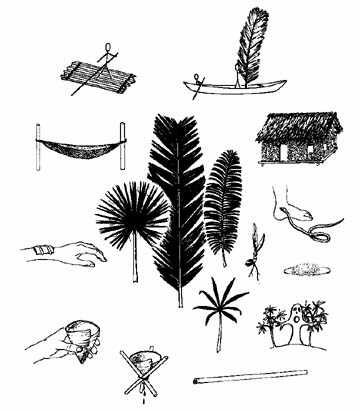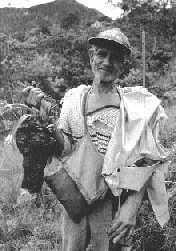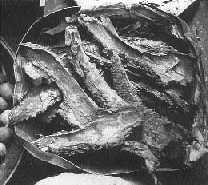Institute
of Economic Botany
Mike Balick and his colleagues at IEB
have produced an impressive number of
publications resulting from their
research on useful plants of the tropics.
They focus on Latin America but carry out
some work in Southeast Asia. IEB
researchers have a special reputation for
their expertise on the use and
classification of palms.
-GJM
Some of the many ways that palm leaves
are used by people (Drawn by Bobbi
Angel). From: Balick, M.J. 1984.
Ethnobotany of palms in the Neotropics.
Advances in Economic Botany 1:9-23.
The New York Botanical Garden Institute
of Economic Botany (IEB) was founded in
1981 in order to focus a portion of the
Garden’s research program on applied
topics of great human concern. Through
its work, IEB seeks to improve our
understanding of the relationship between
people and plants. Its projects encompass
seven main activities:
- collecting
and identifying plants, and
gathering information on their
uses through field research
focused in the tropics;
- studying
natural resource management on
regional and local levels;
- conducting
basic and applied research on
useful plants;
- conserving
biological diversity through
habitat preservation and
germplasm collection;
- disseminating
research results and information
to the scientific community and
the general public;
- teaching
students and training specialists
in economic botany;
- strengthening
the capacity of institutions
worldwide to advance research in
economic botany.
Projects and field activities are
currently carried out in many parts of
the world, including Belize, Bolivia,
Brazil, Colombia, Dominican Republic,
Ecuador, French Guiana, Guatemala,
Guyana, Honduras, Indonesia, Martinique,
Panama, Paraguay, Peru, Thailand, Virgin
Islands and the USA. In Central America,
for example, IEB is working with herbal
healers in rural villages to identify
medicinal plants and to carry out
biodiversity studies linked to
conservation. In Kalimantan, Indonesia,
an inventory of non-timber forest
products is being undertaken, including
gathering data on flower and fruit
production from native trees to obtain an
understanding of sustainable yields. In
Amazonian Brazil, IEB scientists have
completed a palm flora of the region with
information on local names, economic and
subsistence uses, and conservation
status. Research results are regularly
published in scientific journals. The IEB
also edits and publishes the monograph
series Advances in Economic Botany which
addresses selected ethnobotanical
topics in greater depth.
‘Dependence on palms was
inversely related to the
people’s degree of
acculturation. As the natural
resource base declined (including the
availability of palms), people began
to cultivate the so-called modern
crops and reduce their utilization of
wild palms. Seventeen species of
palms were found to be used by these
two groups of Indians of which
Orbignya phalerata, the babassu palm,
was of greatest value yielding a
variety of important products. In
this area palms provide food, fuel,
shelter, fiber, construction
materials, medicine, magic and other
basic necessities of life. Loss of
knowledge concerning palm uses
indicates the urgency with which
plant usage must be catalogued among
indigenous groups.’
From:
Balick, M.J. 1988. The use of palms
by the Apinayť and Guajajara Indians
of northeastern Brazil. Advances in
Economic Botany 6: 65-90.
CONTACT
- Michael
Balick, Director,
Institute
of Economic Botany,
The
New York Botanical Garden,
Bronx, New
York 10458-5126, USA;
Tel.
+1.718.8178763, Fax
+1.718.2206504, e-mail
mbalick@nybg.org
 |
| Some
of the ways that palm leaves are
used by peolple (Drawn by Bobbi
Angel). From: balick, M.J.
1984. enthnobotany of palms
in Neotropics. Advances in
Economic Botany 1:9-23 |
Back
.Centre
for Economic Botany
Drawing
upon more than a century of
ethnobotanical studies at the Royal
Botanic Gardens, Kew, the Centre for
Economic Botany was founded in 1994 by
Ghillean Prance, Kew‘s director. The
head of CEB is Hew Prendergast, formerly
seed collector of Kew’s Seed Bank at
Wakehurst Place.
-GJM
 |
Goldminer
holding Vellozia
sincorana used for
lighting fire, Catoles,
Bahia, Brazil
(Photo:
A McRobb)
|
|
The
Centre for Economic Botany (CEB)
of the Royal Botanic Gardens,
Kew, is involved in a range of
activities focusing primarily on
the drylands of the world. The
Centre maintains SEPASAL (The
Survey of Economic Plants for
Arid and Semi-Arid Lands), a
database on useful plants from
drylands. Drawing together
scientific and traditional
knowledge, the database contains
information on approximately 6000
plant species, excluding the
major crop plants, with data on
geographical distribution, uses,
life-form, life-cycle, habit and
environmental tolerances.
Alongside SEPASAL, Kew runs the
Economic Botany Bibliographic
Database, containing over 150,000
references dealing with plants of
economic value. |
| Other
activities of the Centre include
ethnobotanical research on
anti-malarial plants of the
Amazon; Plantas do Nordeste, a
project working towards the
sustainable development of
natural plant resources in
Northeast Brazil; and Poisonous
Plants in Britain and Ireland, a
joint project with the Poisons
Unit at Guys & St
Thomas’ Hospital Trust,
London, which has produced a
computerized identification
system for poisonous plants. In
addition, CEB holds an extensive
collection of 75,000 plant-based
artefacts from around the world.
Of both historic and scientific
interest, the collections can be
accessed by visiting researchers
at Kew. |
‘Kew has been interested in
Brazil for many years. The Herbarium
contains the mid 19th-century
collections of Richard Spruce from
Amazonia and those of George Gardner
and William Burchell from central
Brazil, as well as many other
important collections that are rich
in type specimens ... It is logical
that we should be working in Brazil
because it is one of the
‘megadiversity’ countries,
having over 50,000 species of
flowering plants ... and a huge range
of ecosystems, including the
rainforests of Amazonia and the
Atlantic coast, the cerrado or
savannas of the central highlands and
the arid desert-like caatinga of the
Northeast ...
Since poorly planned development and
colonisation projects have led to
much destruction of the natural
vegetation of Brazil, it is vital
that we are now involved with
projects that help both to conserve
and use the vegetation in a more
rational and sustainable way. Thus we
have collaborated with many Brazilian
institutions to develop the
“Plantas do Nordeste”
project which covers both
biodiversity and sustainable
development aspects.’
From:
Prance, G.T. 1995. Director’s
message: Brazil. Kew Scientist
7:2.
CONTACT
- Hew
Prendergast, Centre
for Economic Botany,
Royal
Botanic Gardens, Kew,
Richmond, Surrey
TW9 3AB, United
Kingdom; Tel.
+44.181.3325706,
Fax
+44.181.3325278,
e-mail
ecbot@rbgkew.org.uk or
h.prendergast@rbgkew.org.uk
 Semi-arid
caatinga (thorn scrub) vegetation
occupies nearly 50% of Northeast
Brazil, a region that covers nine
states and is roughly two-thirds
the size of Western Europe. Semi-arid
caatinga (thorn scrub) vegetation
occupies nearly 50% of Northeast
Brazil, a region that covers nine
states and is roughly two-thirds
the size of Western Europe. |
Back
Centre for
Indigenous Plant Use Research
Following the development of IPUF,
post-graduate research programs were
started at several universities in South
Africa, and this centre of excellence was
created at the University of Natal,
Durban.
-ABC
.

|
Large
pieces of Warburgia
salutaris (Canellaceae)
bark from Namaacha on the
Swaziland border fro sale
in Maputo, Mozambique
(Photo:
AB Cunningham).
|
|
The
Centre for Indigenous Plant Use
Research (CIPUR) was set up in
1994 following a five year award
(1994-1998) granted to the
University of Natal by the
Foundation for Research
Development (FRD). Its
Ethnobotanical Research Programme
is multidisciplinary, involving
participants from various
departments such as biology,
chemistry, geography,
pharmacology, physiology, social
anthropology and law. The
long-term goal of the Programme
is to develop strategies for the
sustainable utilization and
management of indigenous plant
resources. |
| The
Programme also has the broader
aim of promoting the cultural,
socio-economic, scientific and
health-care benefits to be
derived from the wise use of
indigenous plants. The
development of a Resource Centre,
a post-graduate course in
ethnobotany and the initiation of
wide-ranging post-graduate
projects up to doctoral level
form an integral part of the
CIPUR program. The Resource
Centre provides information on
medicinal and non-medicinal uses
of indigenous plants,
biodiversity, conservation and
rural development. The Centre
includes a collection of recent
publications as well as a
literature database. An
Integrated Information System
(IIS) is being developed,
incorporating a Geographical
Information System (GIS) which
will enable access and
integration of information from
multiple databases. Additional
resources include a photo
catalogue and voucher specimen
collection of medicinal plants.
This is one of the outcomes of a
current survey of the plant trade
at informal markets in the Durban
metropolitan region.
|
‘An Integrated Information
System (IIS) is being developed and
should be fully functional by the end
of 1995. This purpose-designed
database will provide CIPUR with the
means to integrate and access
information from multiple databases
including information derived from
literature, questionnaire-based
surveys and ecological field studies.
These data will be captured so that
retrieval and mapping via a linked
GIS will be possible. Ultimately, the
database will provide a powerful
planning tool for integrating
ecological, socioeconomic and primary
health-care research. Michael Berjak,
the team member involved in the
development of this System, has
recently been commissioned by the
World Wide Fund for Nature to produce
a manual on grass-roots database
design and utilization as part of the
People and Plants Initiative
sponsored by WWF, UNESCO and the
Royal Botanic Gardens,
Kew.’
From:
Higgins-Opitz, S. personal
communication.
CONTACT
- Susan
B. Higgins-Opitz,
Coordinator, Centre
for Indigenous Plant Use
Research, Department
of Biology, University of
Natal, King
George V Avenue, Durban 4001
South Africa; Tel.
+27.31.2601337 or 2603192,
Fax
+27.31.2602029 or 2601195,
e-mail
higgins@biology.und.ac.za
Back
|